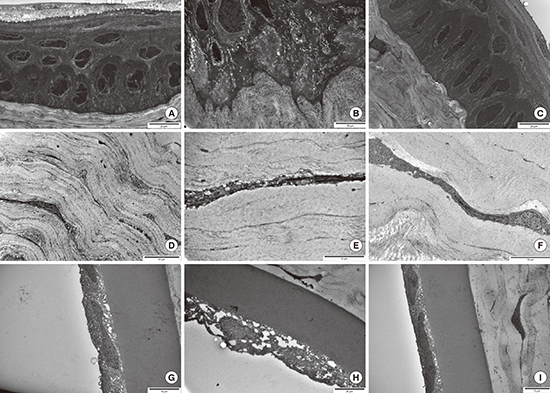1. Filtering surgery. In : Allingham RR, Damji KF, Freedman S, Moroi SE, Shafranov G, Shields MB, editors. Shields' Textbook of Glaucoma. 5th ed. Philadelphia, PA: Lippincott Willliams & Wilkins;2005. p. 568–609.
2. Jampel HD. Effect of brief exposure to mitomycin C on viability and proliferation of cultured human Tenon’s capsule fibroblasts. Ophthalmology. 1992; 99:1471–1476.
3. Smith S, D’Amore PA, Dreyer EB. Comparative toxicity of mitomycin C and 5-fluorouracil in vitro. Am J Ophthalmol. 1994; 118:332–337.
4. Nuyts RM, Felten PC, Pels E, Langerhorst CT, Geijssen HC, Grossniklaus HE, Greve EL. Histopathologic effects of mitomycin C after trabeculectomy in human glaucomatous eyes with persistent hypotony. Am J Ophthalmol. 1994; 118:225–237.
5. Hau S, Barton K. Corneal complications of glaucoma surgery. Curr Opin Ophthalmol. 2009; 20:131–136.
6. Pastor SA, Williams R, Hetherington J, Hoskins HD, Goodman D. Corneal endothelial cell loss following trabeculectomy with mitomycin C. J Glaucoma. 1993; 2:112–113.
7. Shima I, Katsuda S, Ueda Y, Takahashi N, Sasaki H. Expression of matrix metalloproteinases in wound healing after glaucoma filtration surgery in rabbits. Ophthalmic Res. 2007; 39:315–324.
8. Wong TT, Mead AL, Khaw PT. Matrix metalloproteinase inhibition modulates postoperative scarring after experimental glaucoma filtration surgery. Invest Ophthalmol Vis Sci. 2003; 44:1097–1103.
9. Martorana GM, Schaefer JL, Levine MA, Lukowski ZL, Min J, Meyers CA, Schultz GS, Sherwood MB. Sequential therapy with saratin, bevacizumab and ilomastat to prolong bleb function following glaucoma filtration surgery in a rabbit model. PLoS One. 2015; 10:e0138054.
10. Wong TT, Mead AL, Khaw PT. Prolonged antiscarring effects of ilomastat and MMC after experimental glaucoma filtration surgery. Invest Ophthalmol Vis Sci. 2005; 46:2018–2022.
11. Lim DH, Kim TE, Kee C. Evaluation of adenovirus-mediated down-regulation of connective tissue growth factor on postoperative wound healing after experimental glaucoma surgery. Curr Eye Res. 2016; 41:951–956.
12. Polak MB, Valamanesh F, Felt O, Torriglia A, Jeanny JC, Bourges JL, Rat P, Thomas-Doyle A, BenEzra D, Gurny R, et al. Controlled delivery of 5-chlorouracil using poly(ortho esters) in filtering surgery for glaucoma. Invest Ophthalmol Vis Sci. 2008; 49:2993–3003.
13. Weinreb RN, Khaw PT. Primary open-angle glaucoma. Lancet. 2004; 363:1711–1720.
14. Spaeth G, Walt J, Keener J. Evaluation of quality of life for patients with glaucoma. Am J Ophthalmol. 2006; 141:S3–14.
15. Suh W, Kee C. The effect of bevacizumab on the outcome of trabeculectomy with 5-Fluorouracil. J Ocul Pharmacol Ther. 2013; 29:646–651.
16. Dorr RT. New findings in the pharmacokinetic, metabolic, and drug-resistance aspects of mitomycin C. Semin Oncol. 1988; 15:32–41.
17. Parikh CH, Edelhauser HF. Ocular surgical pharmacology: corneal endothelial safety and toxicity. Curr Opin Ophthalmol. 2003; 14:178–185.
18. Nishida T, Saika S. Basic science: cornea, sclera, ocular adnexa anatomy, physiology and pathophysiologic responses. In : Krachmer JH, Mannis MJ, Holland E, editors. Cornea. 3rd ed. St. Louis, Mo: Mosby/Elsevier;2011. p. 3–24.
19. Zarei R, Zarei M, Fakhraie G, Eslami Y, Moghimi S, Mohammadi M, Abdollahi A. Effect of mitomycin-C augmented trabeculectomy on corneal endothelial cells. J Ophthalmic Vis Res. 2015; 10:257–262.
20. Fukuchi T, Hayakawa Y, Hara H, Abe H. Corneal endothelial damage after trabeculectomy with mitomycin C in two patients with glaucoma with cornea guttata. Cornea. 2002; 21:300–304.
21. Daniels JT, Cambrey AD, Occleston NL, Garrett Q, Tarnuzzer RW, Schultz GS, Khaw PT. Matrix metalloproteinase inhibition modulates fibroblast-mediated matrix contraction and collagen production in vitro. Invest Ophthalmol Vis Sci. 2003; 44:1104–1110.
22. Xia X, Jiang Y, Huang P, Wu Z, Zeng Q, Wen J. Cytotoxic effect of mitomycin C on the nonpigmented epithelium of ciliary body in rabbit eyes. Zhonghua Yan Ke Za Zhi. 1998; 34:190–193.
23. Cetinkaya A, Akman A, Take G, Bilezikci B, Akova YA. Ciliary body toxicity of subconjunctival suramin compared with mitomycin-C in the rabbit eye: determining the toxic concentration. Ophthalmic Res. 2009; 41:91–97.
24. Kawase K, Matsushita H, Yamamoto T, Kitazawa Y. Mitomycin concentration in rabbit and human ocular tissues after topical administration. Ophthalmology. 1992; 99:203–207.








 PDF
PDF ePub
ePub Citation
Citation Print
Print




 XML Download
XML Download